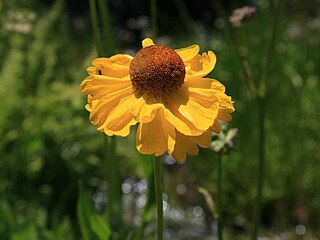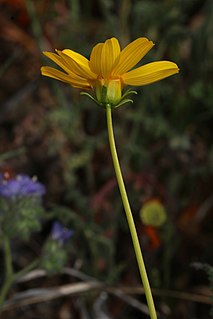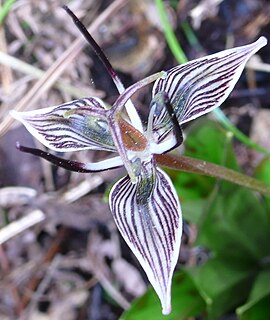
Mahonia aquifolium, the Oregon grape or holly-leaved barberry, is a species of flowering plant in the family Berberidaceae, native to western North America. It is an evergreen shrub growing 1–3 meters tall and 1.5 m (5 ft) wide, with pinnate leaves consisting of spiny leaflets, and dense clusters of yellow flowers in early spring, followed by dark bluish-black berries.

Cylindropuntia bigelovii, the teddy-bear cholla(choy-ya), is a cholla cactus species native to Northwestern Mexico, and to the United States in California, Arizona, and Nevada.

Helenium is a genus of annuals and herbaceous perennial plants in the family Asteraceae, native to the Americas.

Langloisia setosissima, the bristly langloisia, bristly-calico, Great Basin langloisia or lilac sunbonnets, is a flowering plant, the sole species in the genus Langloisia in the family Polemoniaceae. It is native to the western United States and north western Mexico, where it is found in desert washes and on rocky slopes and plains from eastern Oregon and Idaho, south via Nevada and Utah to eastern California and Arizona.

Salix lasiolepis is a species of willow native to western North America.

Ericameria nauseosa, commonly known as Chamisa, rubber rabbitbrush, and gray rabbitbrush, is a shrub in the sunflower family (Aster) found in the arid regions of western North America.

Helenium bigelovii is a North American perennial plant in the sunflower family, commonly known as Bigelow's sneezeweed. It grows in moist areas such as meadows, marshes, or streamsides. It is found at moderate and higher elevations (3000-10,000 ft) in the foothills and mountains of California and Oregon: Cascades, Coast Ranges, Klamath Mountains, Sierra Nevada, etc. Cultivars of the species are used in gardening as ornamentals.

Coreopsis bigelovii is a species of flowering plant in the daisy or sunflower family, Asteraceae, with the common names Bigelow coreopsis and Bigelow's tickseed. It is endemic to California.

Helenium bolanderi is a North American species of flowering plant in the daisy family known by the common name coastal sneezeweed. It is native to southern Oregon and northern California as far south as Mendocino County, primarily along the seacoast.

Scoliopus, or fetid adderstongue, is a genus of plant within the family Liliaceae consisting of two species, Scoliopus bigelovii and S. hallii. Both are found in deep shaded forests, primarily in the coastal counties of the western United States from central California to northern Oregon. The name "Scoliopus" derives from the Greek words skolios and pous, meaning curved foot, a reference to the shape of the pedicel. Taxonomists believe that Scoliopus is closely related to Calochortus, Prosartes, Streptopus and Tricyrtis, which all have creeping rhizomes as well as styles that divide at the tip.
Microseris bigelovii is a species of flowering plant in the family Asteraceae known by the common name coastal silverpuffs. It is native to the west coast of North America, where its range extends from the southern tip of Vancouver Island to the northern coast of California.

Diplacus bigelovii is a species of monkeyflower known by the common name Bigelow's monkeyflower. It is native to the southwestern United States, where it grows in desert and slope habitats. It was formerly known as Mimulus bigelovii.

Scoliopus bigelovii is a species of flowering plant in the lily family known by several common names, including California fetid adderstongue, Bigelow's adderstongue, slinkpod, and brownies. It is native to California, where it is known from the Santa Cruz Mountains, parts of the San Francisco Bay Area and North Coast Ranges. It has also been collected just over the border in Oregon. It occurs in old-growth forest in the understory of redwoods. It grows in mossy, moist places, often in shade.
Pectis imberbis is a species of flowering plant in the family Asteraceae. It is native to Chihuahua and Sonora in Mexico and Arizona in the United States. It is known by the common names beardless chinchweed, beardless fetid-marigold, hierba de venado, and tall chinchweed.
Hastingsia bracteosa is a rare species of flowering plant in the agave subfamily of the asparagus family known by the common name large-flowered rushlily. It is endemic to Oregon in the United States, where it is limited to a twelve-mile stretch of the Illinois Valley in the southwestern part of the state.

Trillium kurabayashii is a species of flowering plant in the bunchflower family Melanthiaceae. The species is endemic to the western United States, occurring in extreme southwestern Oregon, northwestern California, and the Sierra Nevada of northern California. It was first described by John Daniel Freeman in 1975. The specific epithet kurabayashii honors Masataka Kurabayashi, a Japanese cytologist and population geneticist who first postulated the taxon’s existence. It is commonly known as the giant purple wakerobin, a reference to its conspicuously large, dark purple-red flower, one of the largest of any sessile-flowered trillium.

Bidens bigelovii is a North American species of flowering plant in the family Asteraceae. It is native to the southwestern and south-central United States and to Mexico as far south as Oaxaca.
Carphochaete bigelovii, common name Bigelow's bristlehead, is a species of North American flowering plants in the family Asteraceae. They are native to northern Mexico and the southwestern United States.

Dieteria bigelovii, or Bigelow's tansyaster, is a North American species of plants in the family Asteraceae. It is native to the southwestern United States.
Erigeron bigelovii, or Bigelow's fleabane, is a species of fleabane in the family Asteraceae. It is native to northern Mexico and the southwestern United States.















